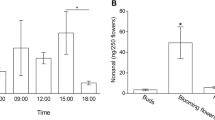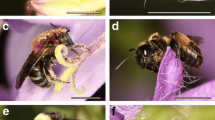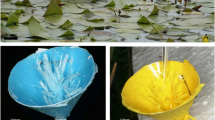Abstract
Specialist and generalist bees use olfactory and visual cues to find and recognise flowering plants. Specialised (oligolectic) bees rely on few host plants for pollen collection. These bee species are suggested to use specific volatiles, but it is unknown whether they have dedicated adaptations for these particular compounds compared to bees not specialised on the same plants. In the present study, we investigated the perception of host odorants and its neuronal substrate with regard to host-plant finding behaviour in oligolectic bees. We reconstructed the antennal lobes (AL) in the Salix specialist, Andrena vaga, and counted about 135 glomeruli and thereby less than the approximately 160 in honeybees. Using calcium imaging experiments to measure neural activity in the bee brain, we recorded odorant-evoked activity patterns in the AL of A. vaga and, for comparison, in the generalist honeybee, Apis mellifera. Our physiological experiments demonstrated that A. vaga bees were particularly sensitive to 1,4-dimethoxybenzene, a behaviour-mediating odorant of Salix host flowers. We found more sensitive glomeruli in the specialised bees as compared to generalist honeybees. This neural adaptation might allow oligolectic A. vaga bees to effectively locate host plants from distances.







Similar content being viewed by others
References
Anton S, Dufour M-C, Gadenne C (2007) Plasticity of olfactory-guided behaviour and its neurobiological basis: lessons from moths and locusts. Entomol Exp Appl 123:1–11
Arenas A, Giurfa M, Farina WM, Sandoz JC (2009) Early olfactory experience modifies neural activity in the antennal lobe of a social insect at the adult stage. Eur J Neurosci 30:1498–1508
Burger H, Ayasse M, Häberlein CM, Schulz S, Dötterl S (2010a) Echium and Pontechium specific floral cues for host-plant recognition by the oligolectic bee Hoplitis adunca. S Afr J Bot 76:788–795
Burger H, Dötterl S, Ayasse M (2010b) Host-plant finding and recognition by visual and olfactory floral cues in an oligolectic bee. Funct Ecol 24:1234–1240
Burger H, Dötterl S, Häberlein CM, Schulz S, Ayasse M (2012) An arthropod deterrent attracts specialised bees to their host plants. Oecologia 168:727–736
Carlsson MA, Bisch-Knaden S, Schäpers A, Mozuraitis R, Hansson BS, Janz N (2011) Odour maps in the brain of butterflies with divergent host-plant preferences. PLoS One 6:e24025
Cure JR, Wittmann D (1990) Callonychium petuniae, a new panurgine bee species (Apoidea, Andrenidae) oligolectic on Petunia (Solanaceae). Stud Neotroph Fauna Environ 25:153–156
Dobson HEM, Bergström G (2000) The ecology and evolution of pollen odours. Plant Syst Evol 222:63–87
Dötterl S, Vereecken NJ (2010) The chemical ecology and evolution of bee–flower interactions: a review and perspectives. Can J Zool 88:668–697
Dötterl S, Füssel U, Jürgens A, Aas G (2005) 1,4-Dimethoxybenzene, a floral scent compound in willows that attracts an oligolectic bee. J Chem Ecol 31:2993–2998
Dötterl S, Milchreit K, Schäffler I (2011) Behavioural plasticity and sex differences in host finding of a specialized bee species. J Comp Physiol A 197:1119–1126
Fernandez PC, Locatelli FF, Person-Rennell N, Deleo G, Smith BH (2009) Associative conditioning tunes transient dynamics of early olfactory processing. J Neurosci 29:10191–10202
Füssel U (2007) Floral scent in Salix L. and the role of olfactory and visual cues for pollinator attraction of Salix caprea L. Dissertation, Universität Bayreuth
Füssel U, Dötterl S, Jürgens A, Aas G (2007) Inter- and intraspecific variation in floral scent in the genus Salix and its implication for pollination. J Chem Ecol 33:749–765
Galizia CG, Menzel R (2001) The role of glomeruli in the neural representation of odours: results from optical recording studies. J Insect Physiol 47:115–130
Galizia CG, Vetter RS (2005) Optical methods for analyzing odour-evoked activity in the insect brain. In: Christensen TA (ed) Methods in insect sensory neuroscience. CRC Press, Boca Raton, pp 349–392
Galizia CG, McIlwrath SL, Menzel R (1999a) A digital three-dimensional atlas of the honeybee antennal lobe based on optical sections acquired by confocal microscopy. Cell Tissue Res 295:383–394
Galizia CG, Sachse S, Rappert A, Menzel R (1999b) The glomerular code for odor representation is species specific in the honeybee Apis mellifera. Nat Neurosci 2:473–478
Kelber C, Rössler W, Roces F, Kleineidam C (2009) The antennal lobes of fungus-growing ants (Attini): neuroanatomical traits and evolutionary trends. Brain Behav Evol 73:273–284
Knudsen JT, Eriksson R, Gershenzon J, Stahl B (2006) Diversity and distribution of floral scent. Bot Rev 72:1–120
Kreissl S, Strasser C, Galizia CG (2010) Allatostatin-immunoreactivity in the honeybee brain. J Comp Neurol 518:1391–1417
Milet-Pinheiro P, Ayasse M, Schlindwein C, Dobson H, Dötterl S (2012) Host location by visual and olfactory floral cues in an oligolectic bee: innate and learned behavior. Behav Ecol 23:531–538
Najar-Rodriguez AJ, Galizia CG, Stierle J, Dorn S (2010) Behavioral and neurophysiological responses of an insect to changing ratios of constituents in host plant-derived volatile mixtures. J Exp Biol 213:3388–3397
Peitsch D, Fietz A, Hertel H, de Souza J, Ventura DF, Menzel R (1992) The spectral input systems of Hymenopteran insects and their receptor-based colour vision. J Comp Physiol A 170:23–40
Pelz D, Roeske T, Syed Z, de Bruyne M, Galizia CG (2006) The molecular receptive range of an olfactory receptor in vivo (Drosophila melanogaster Or22a). J Neurobiol 66:1544–1563
Praz CJ, Müller A, Dorn S (2008) Host recognition in a pollen-specialist bee: evidence for a genetic basis. Apidologie 39:547–557
Raguso RA (2008a) Start making scents: the challenge of integrating chemistry into pollination ecology. Entomol Exp Appl 128:196–207
Raguso RA (2008b) Wake up and smell the roses: the ecology and evolution of floral scent. Ann Rev Ecol Evol Syst 39:549–569
Rath L, Galizia CG, Szyszka P (2011) Multiple memory traces after associative learning in the honey bee antennal lobe. Eur J Neurosci 34:352–360
Sachse S, Galizia CG (2002) Role of inhibition for temporal and spatial odor representation in olfactory output neurons: a calcium imaging study. J Neurophysiol 87:1106–1117
Sedivy C, Praz CJ, Müller A, Widmer A, Dorn S (2008) Patterns of host-plant choice in bees of the genus Chelostoma: the constraint hypothesis of host-range evolution in bees. Evolution 62:2487–2507
Tollsten L, Knudsen JT (1992) Floral scent in dioecious Salix (Salicaceae): a cue determining the pollination system? Plant Syst Evol 182:229–237
Westrich P (1989) Die Wildbienen Baden-Württembergs. Eugen Ulmer, Stuttgart
Zube C, Kleineidam C, Kirschner S, Neef J, Rössler W (2008) Organization of the olfactory pathway and odor processing in the antennal lobe of the ant Camponotus floridanus. J Comp Neurol 506:425–441
Acknowledgments
We gratefully acknowledge B. Rapp who performed the calcium imaging experiments on Apis mellifera, as well as M. Strauch, C. Lutz, and D. Münch who provided statistical tools, and M. Kaminski for the bee photograph. Two anonymous reviewers gave valuable comments on earlier versions of this manuscript. H. B. wishes to thank the Studienstiftung des deutschen Volkes for financial support. All experiments comply with the current laws of the country in which they were performed: in this case, Germany.
Author information
Authors and Affiliations
Corresponding author
Electronic supplementary material
Below is the link to the electronic supplementary material.
Rights and permissions
About this article
Cite this article
Burger, H., Ayasse, M., Dötterl, S. et al. Perception of floral volatiles involved in host-plant finding behaviour: comparison of a bee specialist and generalist. J Comp Physiol A 199, 751–761 (2013). https://doi.org/10.1007/s00359-013-0835-5
Received:
Revised:
Accepted:
Published:
Issue Date:
DOI: https://doi.org/10.1007/s00359-013-0835-5




